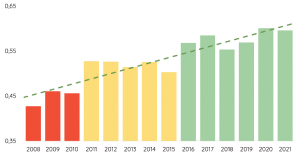DO YOU KNOW WHAT your CUSTOMERS THINK ABOUT YOUR SUSTAINABILITY performance?
We know that sustainability is an important part of the customer experience. We have worked on sustainability issues for over 30 years, but so far only as part of other studies. Now we are taking a big step forward.
In March 2022, our research results were published in Sustainability. The results show that sustainable development is an aspect that is playing an increasingly important role in the customer experience. The development of a model-based Sustainability Index is partly a result of EPSI’s many years of academic research on customer needs, preferences and drivers. EPSI’s Sustainability Index captures the customer’s view of whether their selected supplier is making investments with future generations in mind, is striving for financial success without sacrificing social or environmental factors, and whether the supplier is operating in a socially, environmentally and financially responsible manner.
“Adding a sustainability dimension from a customer perspective has been a big part of our research in recent years. We are now gradually introducing a separate Sustainability Index in our industry studies,” Love Westin explains. “This means that all the companies we measure in the future will be able to find out what their customers think of their sustainability performance, and how this affects satisfaction and loyalty.”









